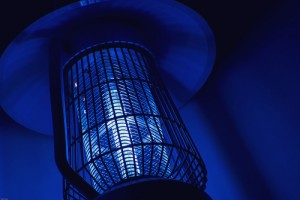In the light of Zika virus threatening the world and winter slowly coming to an end, mosquitoes and many other insects soon will become even bigger problem than they already are. And you want to do everything you can to attract as little of them as possible, so you don’t get bit as often and don’t get infected by one of the diseases they carry. Although mosquito repellents and bug spray will go a long way to help you achieve this, I thought I should explore the topic of lights, more particularly T5 lamps, and do they attract bugs including mosquitoes, to help you ensure that the lighting you are using outdoors or in your home is not attracting more bugs and is not jeopardizing your health. But to find out if T5 lights lure insects, first we should look at how light works and how we and bugs see it.
Because there are many different light spectrums that we can and cannot see,  light is divided into wavelengths that are measured in nanometers to help us define visible and invisible light. We as humans cans see a very small part of all the light that is around us, because the wavelengths that a human eye can perceive are from around 380 to 750 nanometers. Insects are similar to us in that way, because they, too, can see only a small portion of the light spectrum. Only they can perceive light that has smaller wavelengths, therefore the light bugs are attracted to is mostly in the ultraviolet and blue light spectrums and any light above around 650 nanometers, that to us appears as yellow light, is almost invisible to bugs like mosquitoes, flies and other plying insects.
light is divided into wavelengths that are measured in nanometers to help us define visible and invisible light. We as humans cans see a very small part of all the light that is around us, because the wavelengths that a human eye can perceive are from around 380 to 750 nanometers. Insects are similar to us in that way, because they, too, can see only a small portion of the light spectrum. Only they can perceive light that has smaller wavelengths, therefore the light bugs are attracted to is mostly in the ultraviolet and blue light spectrums and any light above around 650 nanometers, that to us appears as yellow light, is almost invisible to bugs like mosquitoes, flies and other plying insects.
So if the light spectrum of your T5 lights are somewhere between 380 and 650 nanometers which would translate to color temperature of about 7,625 Kelvins to 4,458 Kelvins then the light will most likely attract more mosquitoes than you would like. And since one of the most common color temperatures for T5 lights is 6,500 Kelvins, if you buy these kind of T5 bulbs (they are also called the vegetative bulbs) and use them as regular lighting, you will most definitely see more flying insects than you would like.
But that also doesn’t mean that if you use T5 lights, which are for example of 3,000 Kelvin color temperature, they will repel the bugs.  Light by itself doesn’t have the ability to repel anything, instead the 3,000 Kelvin light will just be invisible to the insects, because it is distinctively red spectrum light, so it will just make the illuminated area less attractive to insects like mosquitoes and you probably won’t have to deal with them so much.
Light by itself doesn’t have the ability to repel anything, instead the 3,000 Kelvin light will just be invisible to the insects, because it is distinctively red spectrum light, so it will just make the illuminated area less attractive to insects like mosquitoes and you probably won’t have to deal with them so much.
Another myth that many think of as true is that insects are attracted to the warmth that the light emits. And although it is true that bugs are attracted to the warmth of the human skin, there are multiple other factors that play into why for example mosquitoes can so easily find human targets. So when it comes to lighting the color of the emitted light will be the attractant not the heat that it emits.
In summary, yes T5 lights of specific wavelengths and color temperatures do attract bugs, however, you can still use florescent lights as outdoors lighting during the insect season. You just need to be cautious of what color temperature bulbs you use. Chose bulbs that emit light that either is around 8,000 Kelvins or higher or around 4,100 Kelvins or less and you should be able to enjoy outdoors without attracting more insects like mosquitoes.




